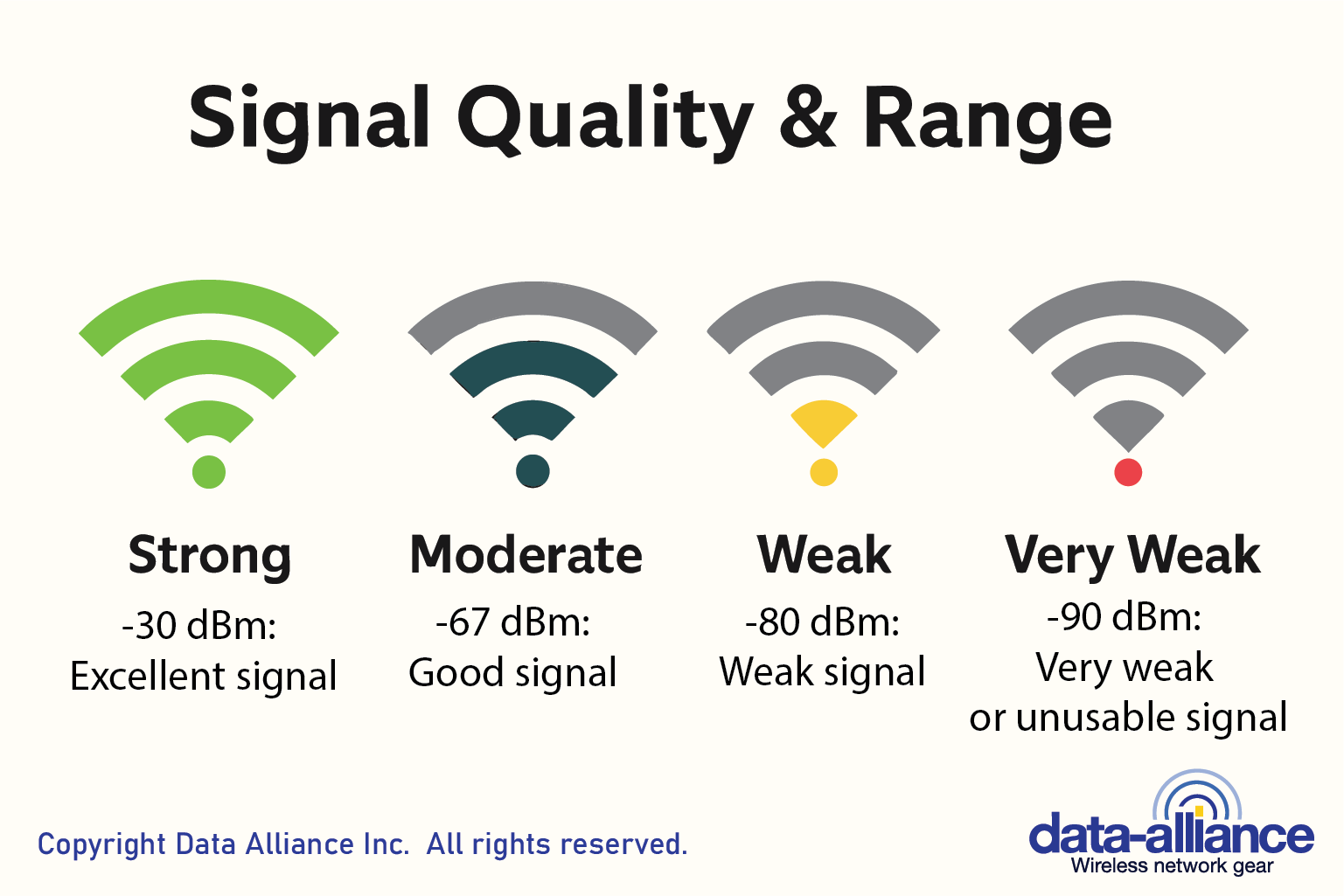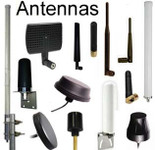- Home
- Antennas, Antenna Cables, Wireless Products: Technical Articles
Antennas, Antenna Cables, Wireless Products: Technical Articles
RSSI & Antenna Performance and IoT Wireless Applications
Antennas | IoT - Internet of Things
April 1st, 2025
6 minute read
RSSI (Received Signal Strength Indicator) is a measurement of the power level of a received radio signal.
RSSI is commonly used in wireless communication systems such as Wi-Fi, Bluetooth, Zigbee, cellular networks, and other RF-based technologies to determine the strength of the signal being received by a device.
Key Points about RSSI:
- Measurement Unit: Usually expressed in dBm (decibel-milliwatts), though sometimes it is presented as a raw value (e.g., 0 to 255) depending on the hardware or software used.
- Scale: Typically a negative number in dBm; closer to 0 means a stronger signal. For example:
- -30 dBm: Excellent signal (very strong)
- -67 dBm: Good signal (acceptable for most applications)
- -80 dBm: Weak signal (might work but could be unstable)
- -90 dBm: Very weak or unusable signal
- Purpose: Helps determine the quality of the connection, range, and stability. A higher RSSI value (closer to 0) generally indicates a better quality of signal.
- Application: Used for site surveys, troubleshooting, and optimizing wireless networks.
Examples of Usage:
- Wi-Fi Networking: RSSI is used to assess the strength of a Wi-Fi signal at various points within a building to optimize router placement.
- Bluetooth Communication: Devices use RSSI to estimate the proximity of other devices (e.g., Bluetooth beacons).
- Cellular Networks: Helps in handoff decisions between cells and determining network quality.
Would you like me to explain how RSSI relates to antennas and IoT wireless applications?
RSSI (Received Signal Strength Indicator) plays a critical role in the performance of antennas and IoT wireless applications.
RSSI & Antennas
Antennas are responsible for transmitting and receiving wireless signals. RSSI is a measure of how well an antenna receives a signal.
- Antenna Gain & RSSI: Higher-gain antennas can capture signals more effectively, resulting in higher (better) RSSI values at the receiver.
- Directional vs. Omnidirectional Antennas:
- Directional antennas focus their energy in a specific direction, which can improve RSSI when aligned properly.
- Omnidirectional antennas provide a more uniform RSSI in all directions but generally at a lower gain than directional antennas.
- Antenna Positioning & Orientation: Small adjustments in an antenna’s position or orientation can significantly impact RSSI. This is crucial in IoT deployments where antennas need to be optimized for maximum signal strength.
RSSI & IoT Wireless Applications
In IoT (Internet of Things) systems, reliable communication is essential. RSSI provides a key metric to evaluate the quality of these connections.

- Signal Quality & Range:
- A higher RSSI (closer to 0 dBm) indicates a stronger, more reliable connection.
- Devices further away from the antenna or in obstructed areas will experience lower RSSI values.
- IoT devices often operate in environments where signal interference and obstructions are common (e.g., inside buildings, industrial settings, urban environments).

- Energy Efficiency:
- Low-power IoT devices often use RSSI to determine whether to increase transmission power or attempt retransmission.
- Efficient use of power is critical for battery-operated IoT devices.
- Network Coverage Mapping:
- During deployment, RSSI is used to map coverage areas for LoRaWAN, Zigbee, Wi-Fi, and other IoT protocols.
- Helps identify dead zones or areas requiring signal boosting or antenna adjustment.
- Mesh Networks:
- RSSI is used to determine the quality of links between nodes in a mesh network (e.g., Zigbee, Thread).
- Devices may dynamically adjust paths based on RSSI to maintain connectivity.
RSSI Optimization for IoT Antennas
- Antenna Selection: Choose antennas with the appropriate gain and radiation pattern for your application (e.g., omnidirectional for general coverage or directional for long-range point-to-point communication).
- Antenna Placement: Optimal placement is critical, especially when dealing with obstructions or metallic surfaces that can reflect or absorb signals.
- Signal Amplification: In some cases, using signal amplifiers or repeaters can improve RSSI for weak signals.
- RSSI Monitoring & Feedback: Regular monitoring of RSSI can help in diagnosing connection issues and improving network performance.
Example Use Cases in IoT Wireless Antenna Systems:
- LoRaWAN: Antenna selection and placement are critical for maximizing coverage area. RSSI is monitored to optimize coverage in urban or rural areas.
- Bluetooth Beacons: RSSI is used to estimate proximity for location-tracking applications.
- Zigbee Networks: RSSI is used to determine mesh connectivity and optimize routing.
- How to Measure and Improve RSSI for Your Antennas and IoT Devices
Measuring and improving RSSI for your antennas and IoT devices involves both hardware-based adjustments and software monitoring techniques. Let's break it down into Measurement and Improvement.
1. Measuring RSSI
Tools & Methods for Measuring RSSI
IoT Devices Built-in RSSI Readings:
- Many IoT devices and modules (e.g., Wi-Fi modules, LoRaWAN nodes, Zigbee devices) provide RSSI readings as part of their status reports.
- Example (LoRaWAN device):bash
AT+RSSI? # Command to check RSSI on a LoRa module - Example (Wi-Fi):bash
iwconfig # Linux command to show RSSI for connected networks - Example (Bluetooth LE):python
peripheral.read_rssi() # Reading RSSI in Bluetooth Python libraries like PyBluez
Software Tools & Apps:
- Wi-Fi Analyzers: Tools like
Wireshark,Acrylic Wi-Fi Analyzer, orNetSpotprovide detailed RSSI readings for various channels and networks. - Bluetooth Scanners: Apps like
nRF Connect(for Bluetooth Low Energy) provide RSSI values for nearby devices. - LoRaWAN Network Servers: Platforms like The Things Network (TTN) report RSSI for received packets.
- Wi-Fi Analyzers: Tools like
Specialized Hardware Tools:
- Spectrum Analyzers: Provide detailed signal strength analysis across various frequencies.
- RF Signal Meters: Handheld devices specifically designed to measure RSSI for RF antennas.
2. Improving RSSI
Antenna Optimization
Antenna Type Selection:
- For point-to-point links (e.g., LoRaWAN over long distances): Use high-gain directional antennas.
- For general area coverage (e.g., Wi-Fi in a building): Use omnidirectional antennas.
Antenna Positioning & Orientation:
- Raise antennas above obstacles for line-of-sight communication.
- Align directional antennas properly toward receiving devices.
Avoid Signal Interference:
- Move away from metallic objects, which can reflect or block signals.
- Minimize the number of obstacles (walls, furniture, etc.) between transmitter and receiver.
Signal Optimization Through Software Configuration
Adjust Transmission Power:
- Increasing transmission power can improve RSSI, but also consumes more energy (especially important for battery-powered IoT devices).
- Example (LoRaWAN):
AT+TXPWR=14 # Setting transmission power to 14dBm - Example (Wi-Fi): Adjusting TX power in router configuration (e.g., 20 dBm, 30 dBm).
Optimize Network Protocols:
- For mesh networks (e.g., Zigbee, Thread): Ensure paths are dynamically optimized by monitoring RSSI.
- For LoRaWAN networks: Adjust Spreading Factor (SF) and Bandwidth (BW) to improve RSSI over long distances.
Hardware Enhancements
- Use RF Amplifiers / Boosters:
- Inline amplifiers can be used to increase signal strength between antenna and device.
- Install Antenna Arrays:
- Using multiple antennas can help improve coverage and signal strength.
- Use High-Quality Cables & Connectors:
- Poor-quality cables/connectors can introduce significant signal loss, reducing RSSI.
Monitoring & Feedback Loop
- Continuous RSSI Monitoring:
- Regularly check RSSI levels and log them over time to identify trends or issues.
- Automated Feedback Systems:
- Create algorithms or scripts to automatically adjust antenna orientation or transmission power based on RSSI readings.
Related Articles
Beamforming: How Modern Antenna Arrays Improve Connectivity
8 minute read
February 15th, 2025
Wi-Fi HaLow Long-Range Wireless IoT OutPerforms LoRa, NB-IoT
6 minute read
February 14th, 2025
Massive MIMO: Game-Changer Cornerstone of 5G Networks
6 minute read
February 3rd, 2025







